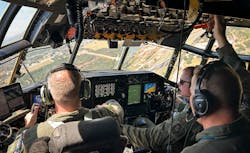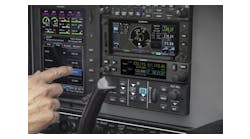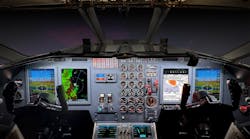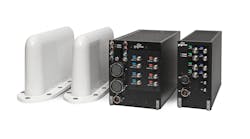By Samuel King Jr., Eglin Air Force Base Public Affairs
The Air Force Reserve Command’s C-130H Hercules fleet began the transition from analog to digital recently with testing beginning on a major upgrade of the aircraft’s avionics system.
The update, called Avionics Modernization Program Increment 2, or AMP Inc 2, is a significant improvement to the almost 60-year-old aircraft’s avionics and navigation systems.
The goal for the AMP Inc 2 modernization effort is supporting mobility air forces to sufficiently meet National Defense Strategy priorities, according to the C-130H legacy avionics branch. The upgrade provides a new flight management system, autopilot, large glass multifunctional displays, digital engine instruments, digital backbone and terrain awareness and warning system.
The 417th Flight Test Squadron’s aircrews were involved in the AMP upgrading since 2017 and began AMP Inc 2 developmental testing in August on one aircraft with others to follow this month.
“This modification completely changes the interface for the crew to employ the C-130H,” said Maj. Jacob Duede, 417th FLTS experimental test pilot. “Aircrew essentially had to print the directions before flying and then type the information in using latitude and longitude or use ground-based navigation aids. This new mod is the newest GPS navigation with a by-name search function and autopilot, all built into the aircraft.”
The built-in flight plan modification ability is particularly impactful for the pilots. Prior to AMP, to modify the flight plan, pilots coordinated with air traffic control, then looked up new coordinates in latitude and longitude with equipment brought onto the aircraft like a tablet or laptop. Then, the pilots took those numbers and entered them into the aircraft to adjust the flight plan.
“Depending on the proficiency of the crew, this could take 30-45 seconds or two to three minutes,” Duede said. “Either of which is a long time when in the air moving at four miles per minute.”
Using the new built-in multifunctional displays, the pilot can complete the entire process with a hand controller in less than 30 seconds.
“The new process is as quick as the first step of the old process. You just identify the point on the moving map, grab it and execute the flight plan,” Duede, a 10-year C-130 pilot, said.
Another new key aircraft component is the Integrated Terrain Awareness and Warning System. It is a commercially used ground-and-object-avoidance tool, but significantly upgraded to react to Air Force tactical flying requirements. The ITAWS, combined with the latest flight navigational programs, are all now built into the aircraft and available on screens easily assessable to the pilot, copilot and navigator. Currently, operational C-130H aircrews carry on tablets or laptops to access any navigational software.
All but three of the aircraft’s original analog gauges are gone to make way for the AMP system. In place of those gauges, that worked independently of each other, are six new brightly lit multifunctional displays working together throughout the aircraft’s flight deck.
“This is much larger than just a software or hardware upgrade,” Duede said. “It’s reconstructing and modernizing the aircraft’s entire cockpit area.”
The planning phase of the 417th FLTS’s developmental testing, or DT, began in 2021 and continues here through the rest of the year.
During the DT flights, aircrew examine all aspects of these newly installed tools, none of which existed within the aircraft before.
“This is an entirely new system,” said Caleb Reeves, 417th FLTS test engineer who helped design the test plan. “Everything we’re testing here is being done for the first time ever in this aircraft. We’re also examining if these untried systems perform in the ways we thought they would or not. That data allows us to adjust our testing and provide feedback to the manufacturer.”
The ITAWS test flights sometimes mean flying at terrain and at obstacles to check if those new warning systems react in the timely fashion and with the clarity.
Once the 96th Test Wing completes DT, the aircraft and mission shifts to Little Rock, Arkansas, where the Air National Guard/AFRC Test Center begins the operational test, or OT, phase.
To better prepare them for OT and the upcoming aircraft changes, AATC pilots augment 417th FLTS aircrew roles during the current DT flying missions. This opportunity gives those aircrews a chance to see and learn the system early. This developmental seat-time helps guide the ANG and AFRC’s new technics, procedures and training that becomes new aircraft standards for all operational units.
More than 23 Air Force Reserve and 54 Air National Guard C-130H aircraft will receive the AMP Inc 2 modification over the next five years at a cost of approximately $7 million per aircraft.



